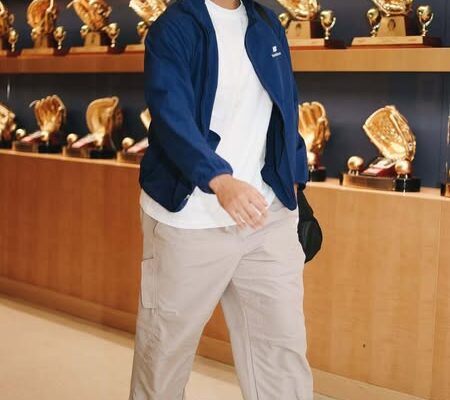Japan’s two-way superstar Shohei Ohtani is breaking baseball’s boundaries and motivating a global generation of athletes, fans, and dreamers in a way that transcends the sport itself. His rise from a small town in Japan to the biggest stages of Major League Baseball has captivated audiences around the world, not just for his astonishing talent as both a pitcher and hitter, but for the humility, discipline, and grace with which he carries himself. In a league that has seen legends come and go, Ohtani’s uniqueness is redefining what is possible in the game, reigniting interest among youth, and inspiring a new wave of players to believe that limits are meant to be shattered.
Ohtani’s story begins in Ōshū, a city in the Iwate Prefecture of Japan, where he was born in 1994. From an early age, he exhibited both a quiet confidence and an unrelenting work ethic, traits that would become trademarks of his career. At Hanamaki Higashi High School, he began to draw national attention in Japan for his ability to throw fastballs exceeding 100 mph and hit towering home runs with equal ease. By the time he was preparing for his professional career, Ohtani faced a critical decision—enter Nippon Professional Baseball (NPB) or immediately pursue his dream of playing in Major League Baseball. He initially expressed a desire to head to the U.S., but after negotiations and persuasion, he joined the Hokkaido Nippon-Ham Fighters of NPB, where he would begin laying the foundation of his two-way legend.
In NPB, Ohtani quickly established himself as a rare talent, making All-Star appearances and showing flashes of greatness both on the mound and at the plate. Still, skeptics remained. Even in Japan, a country rich in baseball tradition, the idea of a full-time two-way player at the professional level was seen as a novelty, not a sustainable reality. But Ohtani proved that belief wrong, and in doing so, he set his sights again on Major League Baseball—this time with the firm conviction that he would play both as a pitcher and a hitter at the highest level in the world.
When he signed with the Los Angeles Angels in December 2017, much of the baseball world was excited but cautious. Some doubted whether Ohtani could maintain such a grueling schedule in the MLB, where travel, competition, and media attention are relentless. Others wondered whether American managers and teams would give him the space to play his dual role. Despite an injury-interrupted rookie season, Ohtani claimed the American League Rookie of the Year Award in 2018, silencing many of his early critics. Yet, it was only a glimpse of what was to come.
The 2021 season marked Ohtani’s full transformation into a global phenomenon. As the first player in decades to be a regular in the batting order while also serving as a starting pitcher, Ohtani did things previously thought impossible. He hit 46 home runs, stole 26 bases, and maintained an ERA below 3.00, drawing comparisons to Babe Ruth—not just in the media, but statistically. He was selected as both a hitter and a pitcher in the MLB All-Star Game, the first time that had ever happened. That year, he won the AL Most Valuable Player Award unanimously, a testament to his dominance on both sides of the game.
Yet beyond the awards and numbers, it was the way Ohtani carried himself that truly captured the world’s imagination. His calm demeanor, respectful attitude, and infectious enthusiasm made him beloved not just in Anaheim, but across baseball fandom worldwide. Children in Japan began practicing both pitching and hitting with dreams of being “the next Ohtani.” Young athletes in countries from Korea to the Dominican Republic to Canada looked to him as proof that versatility and work ethic could take them beyond traditional roles. The global rise of social media further amplified his reach, with highlights of his 450-foot home runs and 100 mph strikeouts going viral on a weekly basis.
In 2023, Shohei Ohtani became an even more legendary figure when he led Team Japan to victory in the World Baseball Classic, striking out his Los Angeles Angels teammate Mike Trout to seal the win in a dramatic final inning. That moment, immortalized by both Japanese and American broadcasters, was not only the pinnacle of baseball drama—it was symbolic. The best pitcher in the world facing off against the best hitter, and both were on the same MLB team. The crowd, the stakes, and the mutual respect between the two stars added emotional weight to a moment that transcended the game. Ohtani’s final strikeout pitch was not just a slider—it was a statement: he belonged among the greatest to ever play.
As Ohtani entered free agency, anticipation swirled around the baseball world about where he would land. In 2023, he signed a record-shattering contract with the Los Angeles Dodgers, one of baseball’s most storied franchises. His move to the Dodgers signaled more than just a change in uniform; it marked a new chapter in his journey, placing him on an even larger stage with World Series expectations and a fan base eager to see him lead the charge. Though his pitching was temporarily paused due to injury, his bat remained lethal. Ohtani continued to draw fans in droves to stadiums across the league, with ticket sales and television ratings rising dramatically wherever he played.
For all his accomplishments, Ohtani remains grounded in a way that feels increasingly rare in professional sports. His press conferences are often humble, his celebrations modest, and his gratitude clear. He regularly credits his teammates, his coaches, and his family for his success. This humility, combined with his transcendent ability, makes him an ideal ambassador not just for baseball, but for sportsmanship itself. His presence is also changing the way front offices think about development. Once upon a time, young athletes were told to specialize—either pitch or hit, not both. But Ohtani’s success has opened doors for a new wave of players who want to break out of those molds. Already, MLB teams are scouting two-way prospects more seriously, with minor league players now being developed under dual roles. The ripple effect is enormous.
Shohei Ohtani’s influence also extends beyond baseball. He is a cultural icon, particularly in Japan, where his games are broadcast live regardless of the time difference. He appears in commercials, magazine covers, and charitable events, always maintaining the image of a disciplined and generous role model. His influence has helped strengthen the bridge between American and Japanese baseball, reinvigorating the interest of global fans who may have felt distant from the MLB. In an era where baseball has at times struggled to compete with other major sports in terms of youth engagement, Ohtani has reignited that flame. Kids now watch baseball highlights on TikTok and YouTube because of him. Merchandise sales in his name have exploded, and Ohtani jerseys are common not just in Los Angeles, but in cities across the globe. Even fans who don’t traditionally follow baseball are aware of his name, his achievements, and his ever-growing legend.
In many ways, Shohei Ohtani embodies the spirit of possibility. His journey reminds us that barriers—be they cultural, physical, or historical—are often meant to be broken. He plays the game with joy and freedom, reminding even the most cynical of fans why they fell in love with baseball in the first place. His career is a story still being written, but already it serves as a beacon for what greatness looks like when paired with humility and discipline.
As the seasons roll on, and Ohtani continues to build his resume, he is not just chasing statistics or records—he is building a legacy. A legacy that speaks to the power of dreams, the value of perseverance, and the beauty of defying convention. In every home run, in every strikeout, and in every moment he steps onto the field, Shohei Ohtani carries with him the hopes of millions who dare to believe that greatness has no borders, and that the game of baseball—and the world—can always be more inclusive, more inspiring, and more extraordinary.



